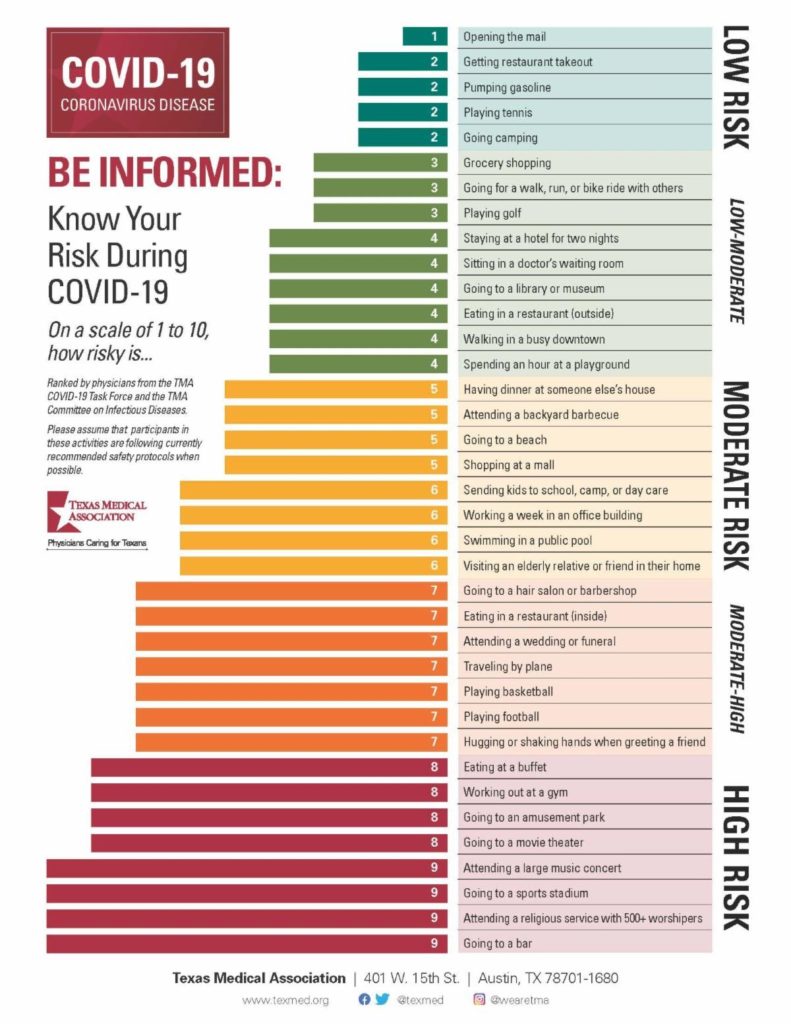
ELLIOTT D. POLLACK
& Company
FOR IMMEDIATE RELEASE
July 20, 2020
The Monday Morning Quarterback
A quick analysis of important economic data released over the last week
I don’t plan on covering all of the Governor’s COVID-19 related press conferences. But, last Thursday’s was worth a review. The information was very helpful and the advice was not new but was certainly worth repeating. The state is starting to move in the right direction according to the latest data. COVID-like illness in emergency rooms have declined. The percentage who test positive is also declining. The measure of the propensity to spread the disease (known as R naught) was below 1.0 last week which represented a 20 basis point drop in just three weeks. That’s good news. And new cases in the state appear to be flattening.
As the Governor pointed out, this is not a reason for a victory lap. We can’t let up. We still have a long way to go. And a couple of week’s data should not be enough to make us comfortable that this is a trend. In addition, there is other data that suggests we still have need of improvements. COVID patient ICU/hospital bed use is still at high levels and hospitals are still stressed due to high capacity, for example. But, it’s a start.
Again, given what we know about COVID-19 today, and that’s a lot more than we did a few months ago, it is still a good idea to remember what needs to be done:
- You are safer at home. That’s true for everyone. And if you’re over 65 or have a compromised immune system, that’s probably where you should be whenever possible.
- Mask up.
- Physical distance.
- Wash your hands frequently.
Yes, I know you’ve heard it before. But, this is the new norm at least until there are therapeutics and a vaccine that will allow us to ease up. The virus is widespread and needs to be taken very seriously by all of us at all times.
Other things you should think about as presented in the press conference include:
• The government will prohibit large gatherings. You should stay away from such events as they are major spreaders of the disease.
• Limit opportunities for catching the disease. The government has closed bars, gyms, movie theaters, concerts, night clubs, water parks, tubing, spring training, large events, large venues, college sports, MLB, NBA and NFL events to the public.
• Know the risks of the activity you are going to when you leave home (See attached chart). In that regard, think about the number of people you will be interacting with. Do you know who they have been interacting with? Do you know who they have interacted with in person? Will you be able to social distance? Is it indoors or outdoors? How long will you be interacting with others?
A few of the other takeaways include a major increase in testing and lab capacity, more contact tracing, measuring the effectiveness of the strategies and continue to monitor the important metrics. Included in those metrics are cases, testing and the percent positive, mobility (limiting nonessential travel), continued measurement of the R naught (the rate of spread) and capacity (the ability to care for Arizonans).
We have a long way to go. We are probably still in the third inning. But, the state, after faltering for a while in thinking about the voracity of the enemy, is now back on track. You live and you learn. That’s a good thing. While what happens in terms of government mandates will be guided by public health issues, the goal has to be to protect, to the extent possible, both people and livelihoods.
As for last week’s economic data, given the reclosure of some parts of the economy that had just opened in May, we know that when July data comes out, it won’t look good. But, by comparing the declines in March and April with the recovery in May and June, we can get a good idea of how the recovery may look when it occurs. That assumes that a follow up to the CARES Act will occur. It’s an election year. So, anticipate an 11th hour solution.
In terms of initial claims for unemployment insurance, while the state’s numbers have been horrific, they are way better than the national numbers. Nationally, the number of people who have filed initial claims equals 33.9% of March employment. For Arizona, its 26.3%. For Arizona, the decline in seasonally adjusted employment between February and April was 9.9%. And the recovery in May and June regained 46.0% of those jobs. The national equivalent numbers were a decline of 14.5% and a recovery of 33.8%.
The seasonally adjusted unemployment rate in Arizona went from 4.5% in February to 13.4% in April. In June it had recovered to 10.0%. While this is still high, it was a great start. The national unemployment rate was 3.5% in February, 14.7% in April and 11.1% today. Arizona so far in 2020 is the second-best performing state in the country. While the year to date numbers are still down, it is down less than 48 other states. And Greater Phoenix so far this year is the best performing major employment market in the country. The housing market in the state continues to do very well given the circumstances. So, to me the glass is half full and I believe we are in a good position to do well in relative terms on the other side of this….if we keep our eye on the ball in terms of doing what we have to do to fight COVID-19.
In terms of the other data, consumer confidence was down. Retail sales were strong. Industrial production was up moderately. Disinflation pressures eased. Mortgage rates were the lowest in history. Mortgage applications were up. National housing permits were modestly up. Builder confidence was up. And housing in the state and its major metro areas had a good month. Again, given the reclosures that have recently occurred due to the flair up of COVID-19 in many parts of the country, I’m not sure this means anything in terms of a trend. But it does show that as of now, the economy had the potential to performs well and that Arizona was leading the pack. How this plays out now is problematic. It depends, as we suggested last week, on the ripple effects and if companies now treat the economic effects as more long term rather than short term. And, by the way, there’s an election in four months.
As for weekly data, national hotel occupancy was 45.9%. That’s 29.7% below a year ago. A month ago, it was down 42.08%. TSA weekly travel throughput, at 4,838,998, was down 62.3% nationally. In Arizona, it was down 64.4%. Applications for business licenses in the state were up a whopping 59.5%. The Google Mobility Index for workplaces was down 40.4% from a year ago in Greater Phoenix. Last week, it was down 34.3%. Not a surprise. And Mobility to retail and recreation places was down 25.9% in Maricopa County last week. A week ago, it was down 24.0%.
There’s more data this week than space allows. It will give me something to show you next week!!
U.S. Snapshot:
• Initial claims for unemployment insurance, not surprisingly, are no longer declining very much. Last week’s number of 1,300,000 was almost identical to the previous week. It was up 499.1% from a year ago. Since mid-March, 51,270,000 people have filed an initial claim for unemployment insurance. That’s 33.9% of March employment.
• The University of Michigan Consumer Sentiment index fell from 78.1 in June to 73.2 in the first half of July. Given the resurgence of the Coronavirus, this is not surprising as people are reassessing the impact of reclosures in parts of the country on their personal finances. This makes it clear how important another aggressive fiscal response is becoming. A year ago, the index stood at 98.4.
• Retail sales continued to rise at an unprecedented rate in June, but that was mostly before the increase in COVID-19 infections caused pauses and reversals in the reopening of the economy. Retail sales jumped a better than expected 7.5% in June after a whopping 18.2% in May. Despite the gain, retail sales were only 1.1% above year earlier levels. This suggests that there’s lots of steam left when COVID-19 is controlled.
• Industrial production rose 5.4% in June after increasing 1.4% in May. Still, it remains 10.8% below year earlier levels. For the second quarter as a whole, the index fell 42.6% at an annual rate, its largest quarterly decrease since the end of World War II.
• The consumer price index rose 0.6% in June following declines in the prior three months. The gain was driven by a bounce in energy prices. All items less food and energy were up a modest 0.2%.
• 30-year fixed rate mortgages rates fell to 2.98%. This is the first time in 50 years that rates fell below 3%. The drop has led to an increase in homebuyer demand.
• The Moody’s CMBS delinquency tracker of the total delinquency rate surged 310 basis points to 5.78% in June. Since the delinquency tracker excludes loans less than 60 days delinquent, the index is finally starting to show the effects of COVID-19. Because of the 60-day requirement, what this really shows is what was going on two months ago. All core subsectors rose, but, the largest increases were in hotel and retail. All regions were impacted.
• Mortgage applications rose by 5.1% over the week of July 10th after a 2.2% increase the previous week. Activity has been normalizing over the past few weeks. Low interest rates are supporting demand. But mortgage supply remains under duress as mortgage lenders have tightened standards with more rigorous income, credit-score and down payment conditions. Greater overall risk in the economy is a factor but so is leaner and more uncertain working capital.
• National housing starts continued their record rebound, increasing from 1,011,000 at an annual rate in May to 1,186,000 at an annual rate in June. Single family starts rose 17.2% in June to 831,000 at an annual rate. Permits also rose for the month. They were up 2.1%.
• The NAHB Housing Market Index rose to 72 in July from 58 in June. The index was 65 a year ago making this sector that has a confidence reading above year earlier levels.
Arizona Snapshot:
• Initial claims for unemployment insurance increased last week to 30,257. That’s 429% over year ago levels. It’s also the highest level since the week of May 16th. Since mid-March, 784,746 Arizonan’s have filed an initial claim. That represents 26.3% of the March level of employment.
• Arizona non-farm employment increased by 19,700 jobs on a seasonally unadjusted basis in June. Historically, non-farm employment had averaged a loss of 51,600 jobs in June. The big decline is usually associated with schools closing for the summer. The big gainers in June were Leisure and Hospitality (comprised of food services, accommodations, and fitness centers, among others), Trade, Transportation and Utilities, Educational and Health Services and Other Services. Overall, jobs in the state were down 3.3% from June 2019. Nationally, jobs were down 8.7% over the same period.
• Employment in Greater Phoenix rose 16,700 on a seasonally unadjusted basis from May to June. The unemployment rate was 9.7%. Jobs were down 3.0% from a year ago In Greater Tucson, jobs were down 2.8% from a year ago. And the unemployment rate was 9.9%. Given the reclosing of some of the sectors opened up in May, employment may be less robust in July.
• The Arizona unemployment rate rose to 10.0% in June on a seasonally adjusted basis (10.3% in a not seasonally adjusted). That’s up from 9.0% in May. That compares to the national unemployment rate that dropped from 13.3% in May to 11.1% in June.
• Single family permits in the Greater Phoenix area were up 4.3% from a year ago and 6.7% year to date. Permits in the Greater Tucson area were up 21.9% from a year ago.
About EDPCo
Elliott D. Pollack & Company (EDPCo) offers a broad range of economic and real estate consulting services backed by one of the most comprehensive databases found in the nation. This information makes it possible for the firm to conduct economic forecasting, develop economic impact studies and prepare demographic analyses and forecasts. Econometric modeling and economic development analysis and planning are also part of our capabilities. EDPCo staff includes professionals with backgrounds in economics, urban planning, financial analysis, real estate development and government. These professionals serve a broad client base of both public and private sector entities that range from school districts and utility companies to law firms and real estate developers.

For more information, contact –
Elliott D. Pollack & Company
5111 N. Scottsdale Rd, Suite 202,
Scottsdale, AZ 85250
480-423-9200











